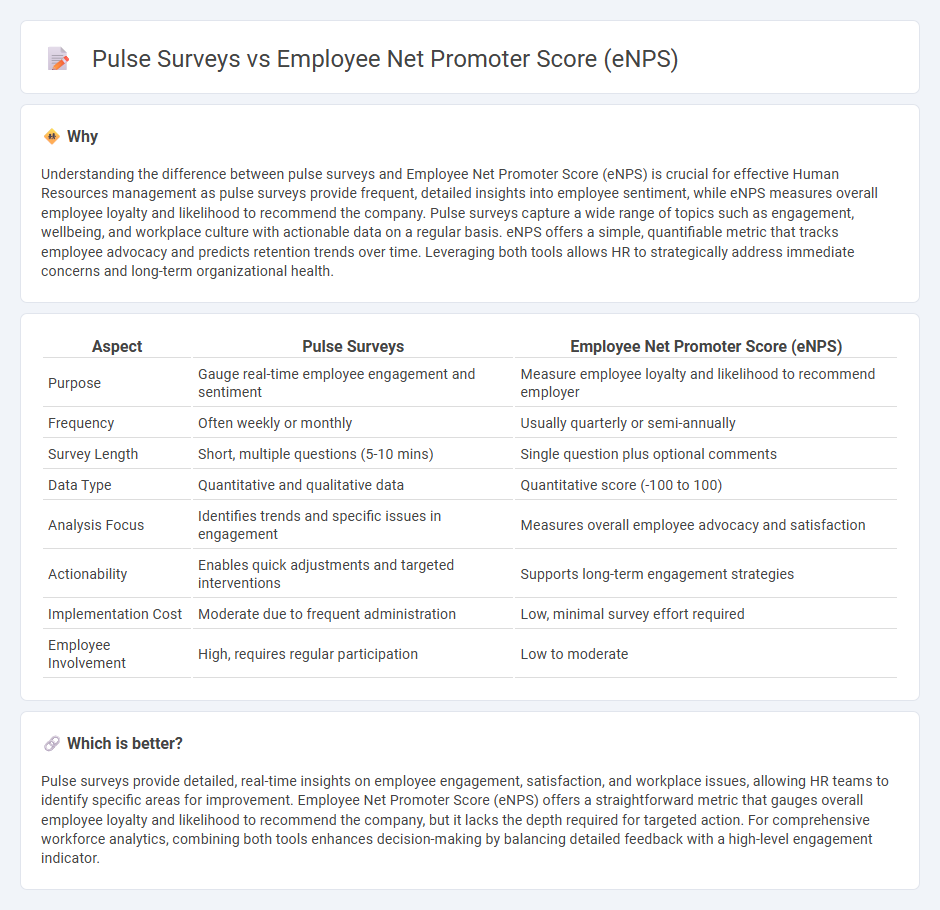
Pulse surveys provide real-time insights into employee engagement through frequent, short questionnaires, allowing organizations to rapidly address workforce concerns. Employee Net Promoter Score (eNPS) measures overall employee loyalty by asking how likely staff are to recommend their workplace, offering a straightforward metric for organizational health. Explore the differences and benefits of pulse surveys and eNPS to enhance your HR strategy.
Why it is important
Understanding the difference between pulse surveys and Employee Net Promoter Score (eNPS) is crucial for effective Human Resources management as pulse surveys provide frequent, detailed insights into employee sentiment, while eNPS measures overall employee loyalty and likelihood to recommend the company. Pulse surveys capture a wide range of topics such as engagement, wellbeing, and workplace culture with actionable data on a regular basis. eNPS offers a simple, quantifiable metric that tracks employee advocacy and predicts retention trends over time. Leveraging both tools allows HR to strategically address immediate concerns and long-term organizational health.
Comparison Table
| Aspect | Pulse Surveys | Employee Net Promoter Score (eNPS) |
|---|---|---|
| Purpose | Gauge real-time employee engagement and sentiment | Measure employee loyalty and likelihood to recommend employer |
| Frequency | Often weekly or monthly | Usually quarterly or semi-annually |
| Survey Length | Short, multiple questions (5-10 mins) | Single question plus optional comments |
| Data Type | Quantitative and qualitative data | Quantitative score (-100 to 100) |
| Analysis Focus | Identifies trends and specific issues in engagement | Measures overall employee advocacy and satisfaction |
| Actionability | Enables quick adjustments and targeted interventions | Supports long-term engagement strategies |
| Implementation Cost | Moderate due to frequent administration | Low, minimal survey effort required |
| Employee Involvement | High, requires regular participation | Low to moderate |
Which is better?
Pulse surveys provide detailed, real-time insights on employee engagement, satisfaction, and workplace issues, allowing HR teams to identify specific areas for improvement. Employee Net Promoter Score (eNPS) offers a straightforward metric that gauges overall employee loyalty and likelihood to recommend the company, but it lacks the depth required for targeted action. For comprehensive workforce analytics, combining both tools enhances decision-making by balancing detailed feedback with a high-level engagement indicator.
Connection
Pulse surveys provide real-time insights into employee engagement, enabling organizations to measure factors that directly influence the Employee Net Promoter Score (eNPS). By regularly collecting feedback through pulse surveys, HR teams can identify trends and address issues that affect employees' likelihood to recommend the company as a great workplace. This connection helps businesses improve retention rates, enhance workplace culture, and drive overall organizational performance.
Key Terms
Employee Engagement
Employee Net Promoter Score (eNPS) measures employee loyalty and likelihood to recommend the workplace, offering a straightforward metric for engagement. Pulse surveys collect frequent feedback on specific employee experience areas, enabling real-time insights into workplace mood and satisfaction. Explore the distinct benefits of eNPS and pulse surveys to optimize your employee engagement strategy.
Feedback Frequency
Employee Net Promoter Score (eNPS) measures employee loyalty through a single, periodic question, offering a snapshot of overall sentiment. Pulse surveys provide frequent, detailed feedback on various aspects of employee experience, enabling organizations to track changes and address issues in real time. Explore how balancing eNPS and pulse survey frequency can enhance workforce engagement strategies.
Loyalty Measurement
Employee Net Promoter Score (eNPS) specifically quantifies employee loyalty by measuring the likelihood of employees recommending their workplace, providing a clear, benchmarkable metric for organizational commitment. Pulse surveys offer broader insights by regularly gauging employee sentiment across various dimensions, including engagement, satisfaction, and well-being, but may lack the singular focus on loyalty that eNPS delivers. Explore how combining eNPS with pulse surveys can create a comprehensive strategy to track and enhance employee loyalty effectively.
Source and External Links
Employee Net Promoter Score (eNPS): 2025 Ultimate Guide - AIHR - eNPS measures employee satisfaction and engagement by asking employees to rate how likely they are to recommend their company; it is calculated as the percentage of promoters (score 9-10) minus the percentage of detractors (score 0-6).
What is employee net promoter score (eNPS)? - HiBob - eNPS is a metric to assess employee job satisfaction by measuring readiness to recommend the company, scored from -100 to 100 by subtracting the percent of detractors from promoters based on a 0-10 scale.
eNPS: what is employee net promoter score & why does it matter? - Leapsome - eNPS is calculated by surveying employees on a 1-10 scale about recommending the company, categorizing scores into promoters (9-10), passives (7-8), and detractors (1-6), then subtracting the percentage of detractors from promoters to gauge engagement levels.
 dowidth.com
dowidth.com